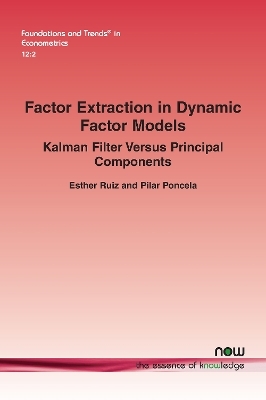
Factor Extraction in Dynamic Factor Models
Kalman Filter Versus Principal Components
Seiten
2022
now publishers Inc (Verlag)
978-1-63828-096-5 (ISBN)
now publishers Inc (Verlag)
978-1-63828-096-5 (ISBN)
Surveys the literature on factor extraction in the context of Dynamic Factor Models (DFMs) fitted to multivariate systems of economic and financial variables. Many of the most popular factor extraction procedures often used in empirical applications are based on either Principal Components (PC) or Kalman filter and smoothing (KFS) techniques.
Factor Extraction in Dynamic Factor Models: Kalman Filter Versus Principal Components surveys the literature on factor extraction in the context of Dynamic Factor Models (DFMs) fitted to multivariate systems of economic and financial variables. Many of the most popular factor extraction procedures often used in empirical applications are based on either Principal Components (PC) or Kalman filter and smoothing (KFS) techniques. First, the authors show that the KFS factors are a weighted average of the contemporaneous information (PC factors) and the past information and that the weights of the latter are negligible unless the factors are closed to the non-stationarity boundary and/or their loadings are pretty small when compared with the variance-covariance matrix of the idiosyncratic components. Second, the authors survey how PC and KFS deal with several issues often faced in the context of extracting factors from real data systems. In particular, they describe PC and KFS procedures to deal with mixed frequencies and missing observations, structural breaks, non-stationarity, Markov-switching parameters or multi-level factor structures. In general, KFS is very flexible to deal with these issues.
Factor Extraction in Dynamic Factor Models: Kalman Filter Versus Principal Components surveys the literature on factor extraction in the context of Dynamic Factor Models (DFMs) fitted to multivariate systems of economic and financial variables. Many of the most popular factor extraction procedures often used in empirical applications are based on either Principal Components (PC) or Kalman filter and smoothing (KFS) techniques. First, the authors show that the KFS factors are a weighted average of the contemporaneous information (PC factors) and the past information and that the weights of the latter are negligible unless the factors are closed to the non-stationarity boundary and/or their loadings are pretty small when compared with the variance-covariance matrix of the idiosyncratic components. Second, the authors survey how PC and KFS deal with several issues often faced in the context of extracting factors from real data systems. In particular, they describe PC and KFS procedures to deal with mixed frequencies and missing observations, structural breaks, non-stationarity, Markov-switching parameters or multi-level factor structures. In general, KFS is very flexible to deal with these issues.
1. Introduction
2. Factor Extraction in Stationary and Static DFMs
3. Non-Stationary Dynamic Factor Models
4. Structural Breaks, Time-Varying Parameters and Markov-Switching DFMs
5. Multi-Level Dynamic Factor Models
6. Matrix-Valued Dynamic Factor Models
7. Missing Observations and Mixed-Frequency Variables
8. Final Remarks
Acknowledgements
References
| Erscheinungsdatum | 19.12.2022 |
|---|---|
| Reihe/Serie | Foundations and Trends® in Econometrics |
| Verlagsort | Hanover |
| Sprache | englisch |
| Maße | 156 x 234 mm |
| Gewicht | 186 g |
| Themenwelt | Wirtschaft ► Volkswirtschaftslehre ► Ökonometrie |
| ISBN-10 | 1-63828-096-7 / 1638280967 |
| ISBN-13 | 978-1-63828-096-5 / 9781638280965 |
| Zustand | Neuware |
| Haben Sie eine Frage zum Produkt? |
Mehr entdecken
aus dem Bereich
aus dem Bereich
Übungsaufgaben – Fallstudien – Lösungen
Buch | Softcover (2022)
De Gruyter Oldenbourg (Verlag)
CHF 34,90
mit Aufgaben, Klausuren und Lösungen
Buch | Softcover (2023)
UTB (Verlag)
CHF 34,85
Set aus Lehr- und Arbeitsbuch
Buch | Softcover (2022)
De Gruyter Oldenbourg (Verlag)
CHF 49,95


